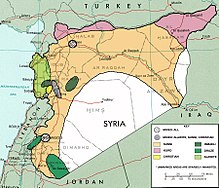
Ethno-religious composition of Syria immediately before the civil war in 2011[1]
The Syrian Civil War is an intensely sectarian war.[2] However, the initial phases of the uprising in 2011 featured a broad, cross-sectarian opposition to the rule of Bashar al-Assad, reflecting a collective desire for political reform and social justice, transcending ethnic and religious divisions.[3] Over time, the civil war has largely transformed into a conflict between ruling minority Alawite government and allied Shi'a governments such as Iran; pitted against the country's Sunni Muslim majority who are aligned with the Syrian opposition and its Turkish and Persian Gulf state backers. Sunni Muslims make up the majority of the Syrian Arab Army (SAA) and many hold high administrative positions, while Alawites and members of almost every minority have also been active on the rebel side.[4][5]
Despite this, Sunni recruits face systematic discrimination in the armed forces and ninety percentage of the officer corps are dominated by Alawite members vetted by the regime; based on their sectarian loyalty to Assad dynasty. SAA also pursues a truculent anti-religious policy within its ranks; marked by animosity towards Sunni religious expressions such as regular observance of salah (prayers), Hijab (headcoverings), abstinence from alcoholic drinks, etc.[6][7] The conflict has drawn in various ethno-religious minorities, including Armenians, Assyrians, Druze, Palestinians, Kurds, Yazidi, Mhallami, Arab Christians, Mandaeans, Turkmens and Greeks.[8][9]
In 2011, all the religious and ethnic communities, Muslim and non-Muslim, Arab, Turkmen or Kurd were united in their uprising against Assadist rule; disenchanted with the regime's corruption, authoritarian repression, nepotism, increasing poverty, unemployment, etc. This early unity highlighted the revolutionary subjectivity challenging the regime's attempts to sectarians the conflict, disputing the notion that the uprising was driven by sectarian reasons.[10] The peaceful movement, characterised by its anti-sectarian and pro-democracy stance, played a crucial role in articulating the non-sectarian grievances against the regime's authoritarian tactics.[11] Bashar al-Assad's strategy of importing Iran-backed Shia fundamentalists engaged in regional conflict with Sunni-majority countries and his portrayal as being the sole defender of Alawite interests from the Syrian Sunni majority; led to the transformation of the conflict into a sectarian war by late 2013.[12] Khomeinist militants have used its influence in regime-held areas to attempt Shi'ification through forced conversions, establishment of shrines, ethnic cleansing and demographic shifts by bringing in foreign Twelver Shia settlers from Iraq, Afghanistan, Pakistan, etc.[13][14][15] Iranian government has been focusing its missionary efforts on converting Syria's Alawite minority to Twelver Shi'ism, by recruiting them in Iranian cultural and religious centres.[16]
- ^ Holliday, Joseph (December 2011). "The Struggle for Syria in 2011" (PDF). Institute for the Study of War. Archived (PDF) from the original on 17 December 2019. Retrieved 21 December 2012.
- ^ Potter, Lawrence G. (2014). Sectarian Politics in the Persian Gulf. New York: Oxford University Press. p. 83. ISBN 978-0199377268.
- ^ Brønd, Thomas Vladimir. "Sectarianism, Revolutionary Subjectivity and War in Syria – the case of the peaceful movement." Confluences Méditerranée 99 (2016): 19-30. P.19.
- ^ Potter, Lawrence G. (2014). Sectarian Politics in the Persian Gulf. New York: Oxford University Press. p. 36. ISBN 978-0199377268.
- ^ Joseph Daher (21 December 2017). "Assad Regime Still Reliant on Fractions of the Sunni Bourgeoisie - حكاية ما انحكت". SyriaUntold. Retrieved 19 August 2020.
- ^ Bou Nassif, Hicham (4 August 2015). "'Second-Class': The Grievances of Sunni Officers in the Syrian Armed Forces". Journal of Strategic Studies. 38 (5). Routledge: 626–649. doi:10.1080/01402390.2015.1053604. ISSN 0140-2390. S2CID 216087910 – via tandfonline.
- ^ Albrecht, Ohl, Holger, Dorothy (March 2016). "Exit, Resistance, Loyalty: Military Behavior during Unrest in Authoritarian Regimes". Perspectives on Politics. 14 (1). Cambridge University Press: 47–49. doi:10.1017/S1537592715003217. S2CID 147656813 – via Cambridge Core.
{{cite journal}}: CS1 maint: multiple names: authors list (link) - ^ Cite error: The named reference
PutinPositionOnSyriawas invoked but never defined (see the help page). - ^ Sengupta, Kim (20 February 2012). "Syria's sectarian war goes international as foreign fighters and arms pour into country". The Independent. Antakya. Archived from the original on 22 February 2012. Retrieved 22 February 2012.
- ^ Brønd, Thomas Vladimir. "Sectarianism, Revolutionary Subjectivity and War in Syria – the case of the peaceful movement." Confluences Méditerranée 99 (2016): 19-30. P. 21.
- ^ Cannone, Martina. "Sectarianism and Ethnic Group Mobilization: The case of the Syrian civil war." Bachelor's thesis, Leiden University, 2021. P. 45. [https://hdl.handle.net/1887/3243885]
- ^ Baltacioglu-Brammer, Ayse (November 2013). "Alawites and the Fate of Syria". OSU.EDU. Ohio State University. Archived from the original on 7 July 2022.
- ^ "Through Evangelism and Settlements, Iran Is Remaking Syria in Its Image". Mosaic. 24 January 2023. Archived from the original on 24 January 2023.
- ^ "Iran's stakes in Syria". GIS Reports. 28 October 2021. Archived from the original on 19 May 2023.
- ^ Yahel, Ido (17 June 2021). "Iran in Syria: From Expansion to Entrenchment". Tel Aviv Notes. 15 (5): 1–6. Archived from the original on 4 December 2022 – via Moshe Dayan Center for Middle Eastern and African Studies.
- ^ Yahel, Ido (17 June 2021). "Iran in Syria: From Expansion to Entrenchment". Tel Aviv Notes. 15 (5): 1–2. Archived from the original on 4 December 2022 – via Moshe Dayan Center for Middle Eastern and African Studies.
© MMXXIII Rich X Search. We shall prevail. All rights reserved. Rich X Search
